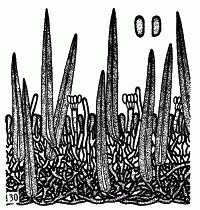|
 Hymenochaete innexa Hymenochaete innexa
BiostatusPresent in region - Indigenous. Non endemic
Images (click to enlarge)
Caption: FIG. 30. Hymenochaete innexa G.H.Cunn. Transverse section x 500; spores x 1000. |
Article: Cunningham, G.H. (1957). Thelephoraceae of New Zealand. XIV. The genus Hymenochaete. Transactions of the Royal Society of New Zealand 85(1): 1-51.
Description: Hymenophore resupinate, annual, membranous, adnate, at first developing as numerous small
orbicular colonies 2-5 mm across, merging to form linear areas to 8 x 3 cm. Hymenial surface
ferruginous, becoming umber or reddish-brown, velutinate, not creviced, margin thinning out,
bay or fawn, fibrillose, adnate. Context ferruginous, together with the hymenium 50-100 µ
thick, a narrow zone of intertwined partly cemented hyphae embedding the setae; hyphal
system monomitic, generative hyphae 2.5-3 µ diameter, walls 0.5 µ thick, golden brown,
branched, septate. Setal layer occupying most of the fructification, composed of 2-3
overlapping rows of setae which arise from the subhymenium and context, project to 65 µ,
are subulate, 55-80 x 8-10 µ, with walls naked, reddish-brown, lumina narrow. Hymenial
layer to 25 µ deep, a close palisade of basidia, paraphyses and paraphysate hyphae. Basidia
subclavate, 14-18 x 3.5-4 µ, 4-spored; sterigmata arcuate, slender, to 5 µ long. Paraphyses
clavate, same diameter but shorter than the basidia. Paraphysate hyphae brown, filiform, to 3
µ diameter. Spores elliptical, apiculate, 5.5-7 x 2.5-3 µ, walls.smooth, hyaline, 0.1 µ thick.
Habitat: HABITAT: Effused on bark of dead branches associated with a white rot.
Distribution: DISTRIBUTION: New Zealand.
Notes: There are few outstanding features separating the species from others of this section. The
hymenial surface is ferruginous, becoming umber or reddish-brown because of projecting
setae, and tardily or not creviced. The context is composed of 2-3 overlapping rows of setae
embedded in intertwined, partly cemented hyphae. Setae project to 65 µ, are naked, fairly
broad for their length, and associated with coloured paraphysate hyphae. Spores are elliptical
and vary somewhat in size; in one collection they are 7 x 3 µ, in a second 6 x 2.5 µ. The
fungus produces a soft white rot in the host tissues. It has the largest setae of the four related
species H. innexa, H. minuscula, H. corrugata and H. separata. The interwoven hyphae free
from crystals separates it from H. minuscula and H. separata; and narrower setae and
different spores separate it from H. corrugata.
|